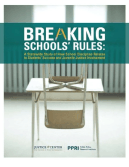Themes in the News for the week of July 18-22, 2011 by UCLA IDEA | http://bit.ly/oNjVQg
07-22-2011 - A new study by the Council of State Governments Justice Center reveals drastic and varied student disciplinary policies. For the first time, researchers used longitudinal data to track suspensions and expulsions and relate them to students’ rate of high school graduation.

The disciplinary actions are strongly associated with student success. Of all the suspended and expelled students, almost a third had to repeat a grade level and a tenth dropped out of high school (Schools Matter).
The report also highlighted very large differences in how often and for what purposes schools chose to discipline students. Only 3 percent of the suspensions and expulsions documented were mandated by state policy. The remainder were discretionary moves made by individual schools and districts, with those infractions including dress code violations, tardiness, not turning in homework, and disruptive classroom behavior (Boston Globe).
Districts officials and school personnel may turn to suspension and expulsion because they lack the resources, programs, or training to address undesirable student behavior. “I know it’s a cliché, but when all you have is a hammer, every problem looks like a nail,” said a Texas school district official who oversees discipline policies (NPR).
Though California’s figures are not as high as Texas’, they do support the main points of the study. During the 2009-10 school year, California recorded more than 757,000 suspensions and 21,000 expulsions. There are dramatic differences among California schools in the incidence of these disciplinary actions. Some high schools report more than 50 suspensions or expulsions for every 100 students enrolled while others report fewer than 5 such actions for every 100 students.
There is evidence that different approaches to school discipline can dramatically reduce the numbers of suspension and expulsions. Strategies like “Positive Behavioral Support,” which encourage educators to model appropriate behavior and intervene with corrective measures before discipline problems become too big, have reduced suspension rates when implemented with fidelity. It is also the case that small, well-staffed schools that personalize instruction foster environments where students and adults know and care about one another and about learning.
These sensible approaches to reducing suspension and expulsion rates are hard to advance in a period of budget cuts. California schools lack funds for professional development to train teachers in new strategies. Schools with fewer teachers and counselors find it hard to individualize instruction and support. Layoffs to community liaisons and office staff often mean the loss of a stable community presence. When IDEA surveyed California high school principals last summer, 46 percent said that cutbacks to staff had made their schools less safe.
Making California’s schools safer and more inclusive will require different strategies, more resources and better data. The state has just enough disciplinary data to know it has a big problem, but not enough to be able to fix it: California disciplinary data isn’t reported by race, special education, type of infraction, or even whether infractions are attributed to multiple students or repeat actions by one.
Officials cannot review shortcomings in schools’ disciplinary policies if they can’t track and make sense of the widely disparate enforcement. Clearly, some schools are over-eager to exclude students while other schools seem to have successful policies to address misbehavior with many fewer suspensions and expulsions.
Breaking School Rulessmf: This is something that LAUSD is on the cutting edge of – at least for traditional schools (charters, pilots, partnerships, i-Design, etc. schools can claim exemption from the LAUSD Discipline Policy.)
Plus the referenced study is of Texas schools – the same folks who brought us No Child Left Behind - where Creationism is taught in science class and discipline policy involves paddling students.
I have sat on the LAUSD Discipline Foundation Policy Task Force for a number of years and the program, discussion and good work has been truly exemplary …despite my divisive influence!
Please visit the LAUSD Discipline Foundation Policy/School-wide Positive Behavior Support website here – and then get involved in your school’s discipline policy team!


No comments:
Post a Comment